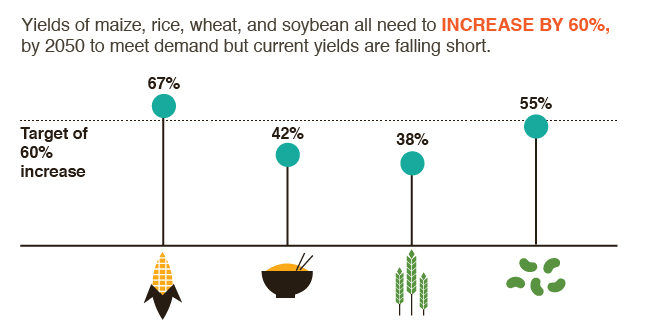Food Production and Trade

Facts
Food Production Outlook
- OECD-FAO predicts that global agricultural production will grow at an average of 1.5% annually over the next 10 years, compared with 2.1% in the previous decade. Growth is expected to be slower in all crop sectors and in livestock production. These trends reflect rising costs, growing resource constraints and increasing environmental pressures, which are expected to inhibit supply response in virtually all regions (OECD-FAO 2013 p. 19).
- Global cereal production is expected to increase by 1.4% per year in the next decade, with 57% of total growth coming from middle-income and low-income countries (OECD-FAO 2013 p. 10).
- Increased production must be met through higher yields because increasing the area of land under agriculture carries major environmental costs. Although there is more land that could be used for agriculture, most of it is under forests, wetlands or grasslands, and converting these to cropland would greatly increase greenhouse gas emissions and cause the loss of biodiversity and important ecosystem services (Garnett et al. 2013 p. 33).
- Less-intensive, generally lower-yielding production may generate local environmental benefits, but may have indirect consequences, in particular clearing land for agricultural production to compensate for lower yields (Garnett et al. 2013 p. 33).
- OECD-FAO (2013) estimates that yields of wheat and coarse grains (maize, barley, sorghum, rye, oats, millet, and mixed grains) will increase by about 12% on average between 2013 and 2022. This is well above the yield increases forecast for other crops such as sugar cane and cotton and below those for oilseeds. The area under coarse grains is projected to grow faster than that under wheat or rice (OECD-FAO 2013 p. 124).
- World milk production is projected to increase by 168 million tonnes, the majority of which (74%) is expected to come from middle-income and low-income countries (OECD-FAO 2013 p. 208).
Current Food Production
- Yields of rice and wheat are increasing very slowly in the top-three rice- and wheat-producing nations. Rice yields in China, India and Indonesia are increasing by only 0.7%, 1.0% and 0.4% per year, respectively. Wheat yields in China, India and the USA are increasing by only 1.7%, 1.1% and 0.8% per year, respectively (Ray et al. 2013 p. 6).
- Based on current supply and demand prospects, by the end of seasons in 2014, world cereal inventories could have grown by 11% to 569 million tonnes, the highest level in 12 years. Stocks of all major cereals are forecast to increase, with coarse grains increasing the most (FAO 2013a p. 1).
Food Trade
- Global cereal trade in 2013/14 marketing season is forecast to reach 306.5 million tonnes, up slightly from 2012/13. World trade in coarse grains is expected to expand by 3.8% to an all-time high of 133 million tonnes in 2013/14 (FAO 2013b).
- Global trade in soybeans and soybean products has risen rapidly since the early 1990s, and has surpassed not only wheat—the traditional leader in agricultural commodity trade—but also total coarse grains. Continued strong growth in global demand for vegetable oil and protein meal, particularly in China and other Asian countries, is expected to maintain soybean and soybean-product trade well above wheat and coarse grains trade throughout the next decade (USDA 2011 p. 22).
- Global rice trade is projected to grow by 2.7% per year from 2011 to 2020. In 2020, global rice trade is expected to reach 41 million tonnes, 30% above the 2006 record. The main factor driving this expansion in global trade is a steady growth in demand—largely due to population growth in developing countries (USDA 2011 p. 32).
Sources and further reading
- [FAO] Food and Agriculture Organization of the United Nations. 2012. Price volatility from a global perspective. Rome: FAO.(Available from http://www.fao.org/fileadmin/templates/est/meetings/price_volatility/Price_volatility_TechPaper_V3_clean.pdf)
- [FAO] Food and Agriculture Organization of the United Nations. 2013a. Food outlook: Biannual report on global food markets. June 2013. Rome: FAO. (Available from http://www.fao.org/docrep/018/al999e/al999e.pdf)
- [FAO] Food and Agriculture Organization of the United Nations. 2013b. FAO cereal supply and demand brief [webpage]. http://www.fao.org/worldfoodsituation/csdb/en/ (Accessed on 6 November 2013)
- [FAO] Food and Agriculture Organization of the United Nations. 2013c. FAO food price index [webpage]. http://www.fao.org/worldfoodsituation/foodpricesindex/en/ (Accessed on 6 November 2013)
- [FAO] Food and Agriculture Organization of the United Nations. 2013d. FAO price volatility [webpage]. http://www.fao.org/economic/est/issues/volatility/en/ (Accessed on 6 November 2013)
- Garnett T, Appleby MC, Balmford A, Bateman IJ, Benton TG, Bloomer P, Burlingame B, Dawkins M, Dolan L, Fraser D, Herrero M, Hoffmann I, Smith P, Thornton PK, Toulmin C, Vermeulen SJ, Godfray HCJ. 2013. Sustainable intensification in agriculture: Premises and policies. Science 341:33–34. (Available from http://dx.doi.org/10.1126/science.1234485)
- Ray DK, Mueller ND, West PC, Foley JA. 2013. Yield trends are insufficient to double global crop production by 2050. PLoS ONE 8(6): e66428. doi:10.1371/journal.pone.0066428.
- [OECD-FAO] Organisation for Economic Co-operation and Development-Food and Agriculture Organization of the United Nations. 2013. OECD-FAO agricultural outlook 2013. Paris: OECD Publishing. http://dx.doi.org/10.1787/agr_outlook-2013-en (Accessed on 6 November 2013)
- [USDA] United States Department of Agriculture. 2011. USDA Agricultural projections to 2020. Washington, DC: Economic Research Service, USDA. (Available from http://www.ers.usda.gov/publications/oce-usda-agricultural-projections/oce-111.aspx) (Accessed on 6 November 2013)